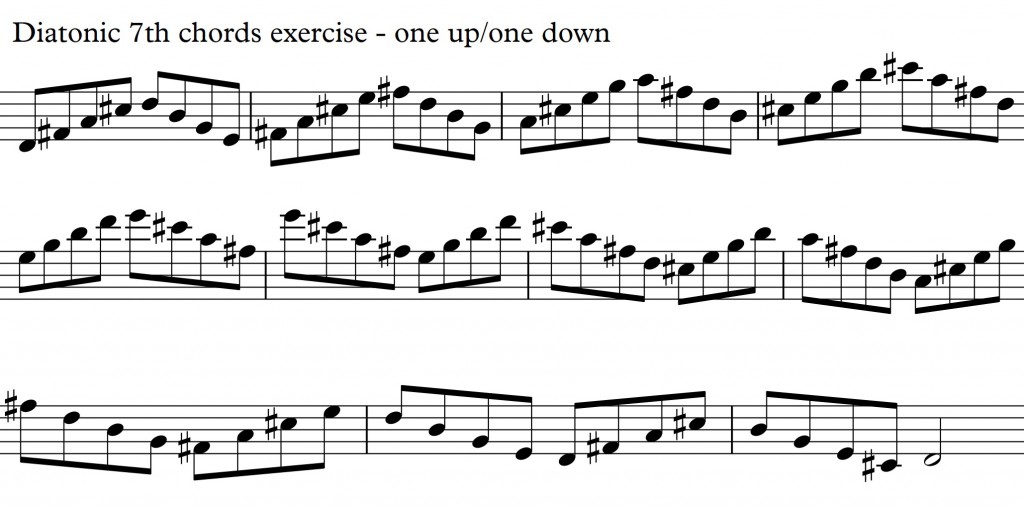In this video I will play three examples and explain how to use the, in earlier videos explained, pentatonic groups over a blues.
All posts by Søren Ballegaard
Blues basics 4 – pentatonics and approach notes
I have divided the pentatonic scale into small groups around the roots of the blues chords. These groups i will use to approach the roots in the blues, its simpler than it sounds 🙂
I have devided the pentatonic scale into groups.

the groups are associated with the roots of the chords in the blues. The D, G and A.

Ill apply the groups and use them to target the root of the next bar.
in the following example i play the root of the chord on beat one. In the bar before I approach the one with the group belonging to the coming root.
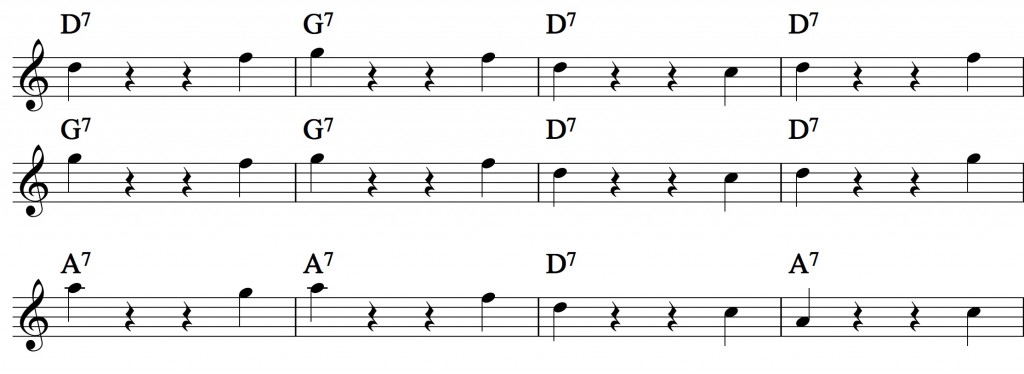
You can see that the root is on the one of each bar and leading to the root I use the notes in the group of the coming root. Leading towards bars with the root D I use F and C as approach notes, leading to a G bar i use A and F and leading to an A bar i use the approach notes C and G. All connected through the groups beloning to the root.
You see in the above example that I in the first bar leading to the second bar, on the four, apply F leading to the G of the second bar. Bar two to three i connect with the approach note C in the group of D. On the ninth bar i apply the G leading to the A. The rule would be that i look in the coming bar for the root and backwards i apply the group beloning to the coming bar.
In the next example i only use the approach note from above. The notes would be F to D, A to G and C to A.
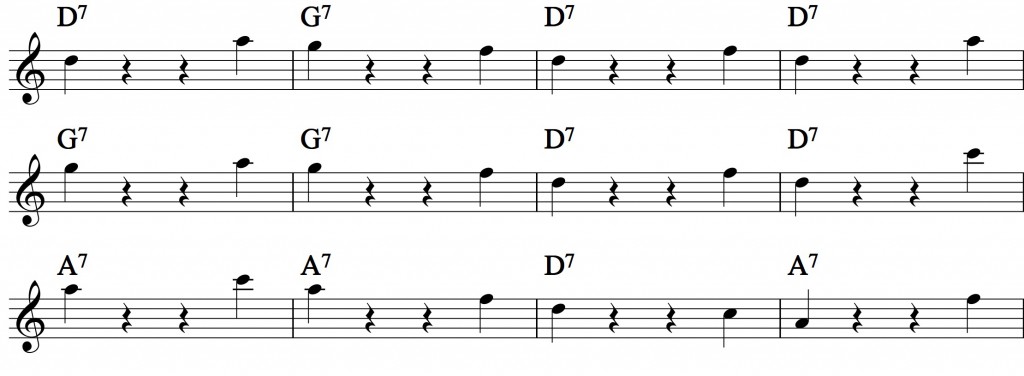
Its clear that the notes are upper approach note in the groups.
This exercise is only applying the notes below the root.
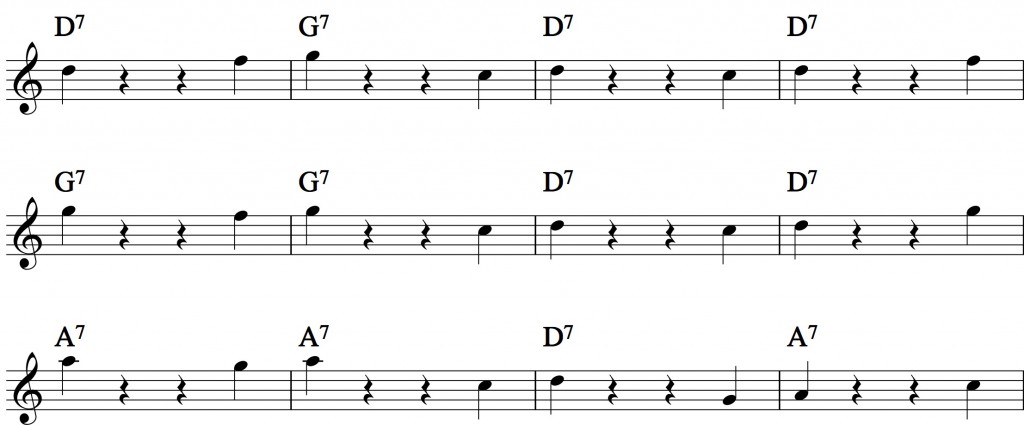
C to D, F to G and G to A. Playing towards the target note which in this case is the root.
This way of practising playing towards a target note is quite simple and easy to get used to.
When soloing in jazz music its common practise that you always play towards a target note to get a clear melodic line.
I go on to the next exercise where i change the approach notes. I dont play only one direction anymore but pick the approach note freely, above or below.
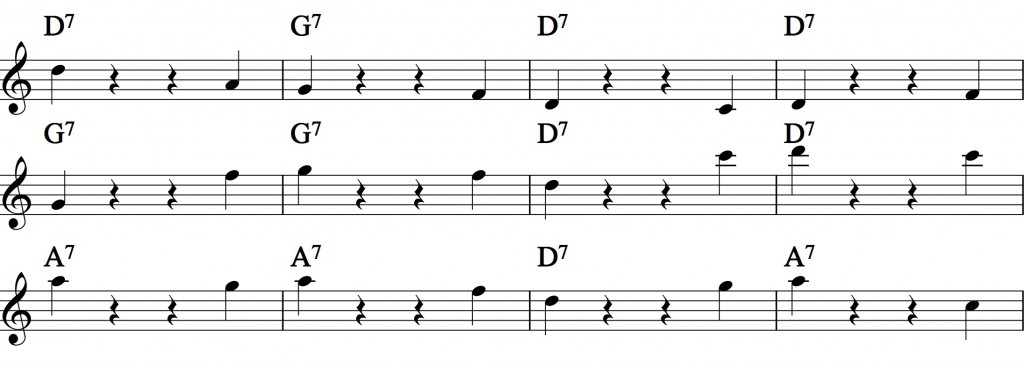
The most important to understand in this lesson to do this a lot, to get this way of playing into your ears and fingers.
in the coming exercise i play the approach note as an eight note so, keeping the same rhythm in the whole exercise but changing which approach note i use, above or below.
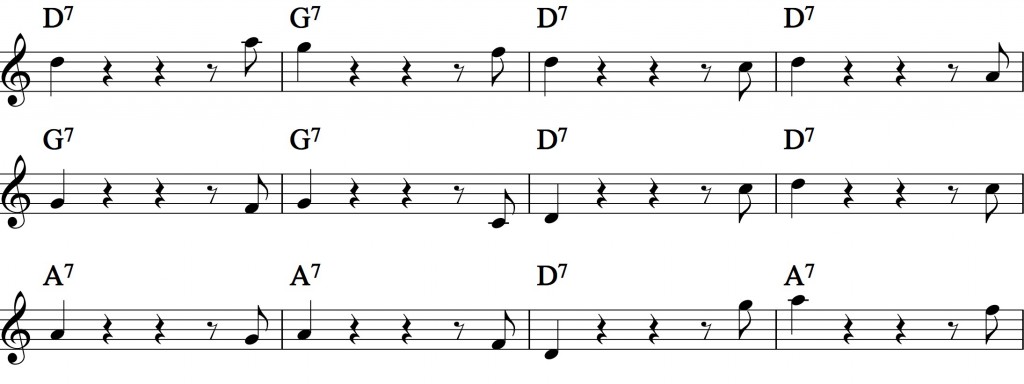
You can always add more rhythm which the next exercise will illustrate.
Playing two eight notes approach and melodically choosing the above or the below lying note.
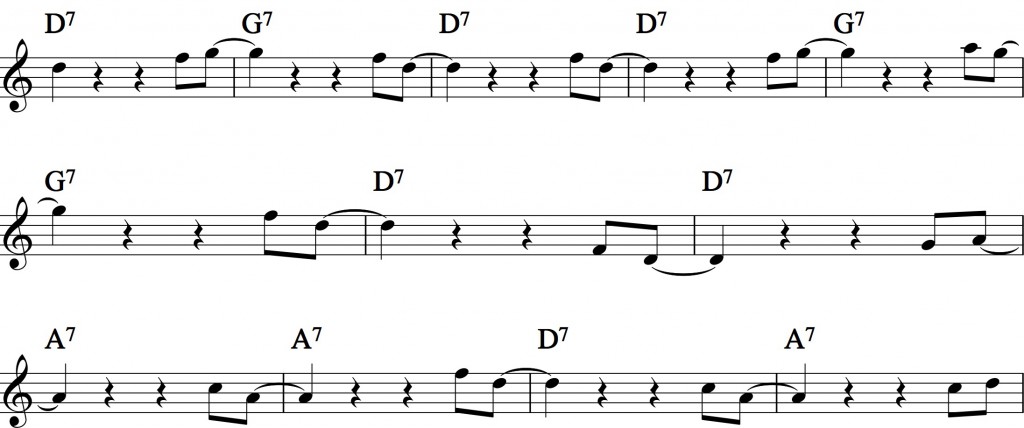
The more notes and rhythm you add before the target note the more complicated it gets of course.
In my next video ill get into more more examples where i use more approach notes.
Let me know if you have questions about this.
I hope that these videos inspires you as much as they inspire me.
Enjoy and have fun playing 🙂
If you want to stay up-to-date with my videos:
subscribe to my newsletter (top left of my website)
subscribe to my youtube-channel.
You can also find me on twitter, instagram, facebook and google+ as sorenballegaard
Blues basics 3 – applying the pentatonic scale chord groups in blues examples
Still playing the (basic) blues!
In this video lesson i give examples in how to apply the, in earlier videos, mentioned groups in a blues solo.
I have made some examples of how you can play the blues using the pentatonic scale divided into groups around the roots of the chords of a basic blues.
Example one – played two times
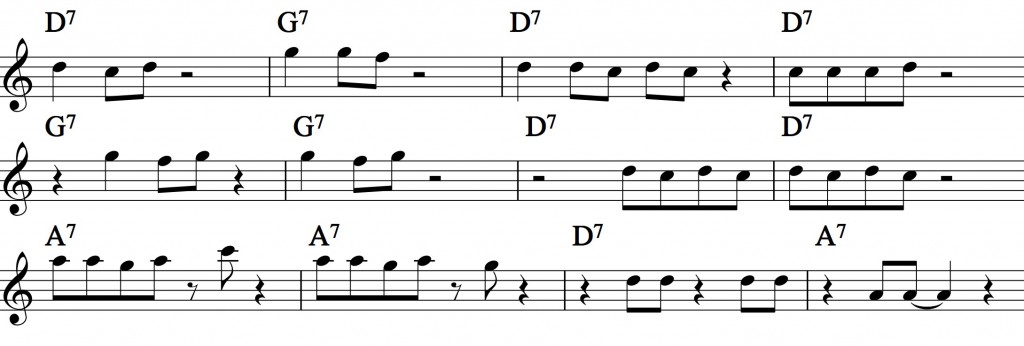
In these examples i stay inside the groups and in most bars I start the line on the root note.
I start the first bar with the D group – root D one below C and then again the D, second bar i play the root G twice and the note below, the F. third bar – D and switch between the root and the note below C. ending the first four bars with not beginning on the root but answering to the third bar with starting on the note below C thrice and ending on the D.
Fifth bar I do not start on the first beat but on the second beat G F G, the pattern from the very first bar, continuing on the sixth bar repeating the pattern from the fifth bar, but placed on the first beat, as an answer to the fifth bar. The seventh and eights bar I build together in a continuing string of notes D C D C D C D C, getting into the feel of playing longer eight note lines. In the ninth and tenth bar i repeat a pattern in the A group – A A G A but add a tail ending in bar nine on a C and bar ten on a G leading the way towards bar eleven, a rhtymical pattern on the two and four – kind of bass pedal like on the root D and bar twelve A.
Example two:
The lines in this bar is more in continuation of each other, which means that the lines grow longer and are not individually placed but mostly answers or follow up on the previous line.
I also slowly move away from always beginning on the root. Fx. i can start the D group on F or C also, a line on the G group can be started on the F or the A, and in the A group i can start on the G or the C for example.
important to know is that you can start a line on these other notes but due to our limited material the starting note fx the F on a D does not mean that the F really sounds like D. Consider it more a leading tone towards D. The D is still nessesary to make the D bar sound like D.
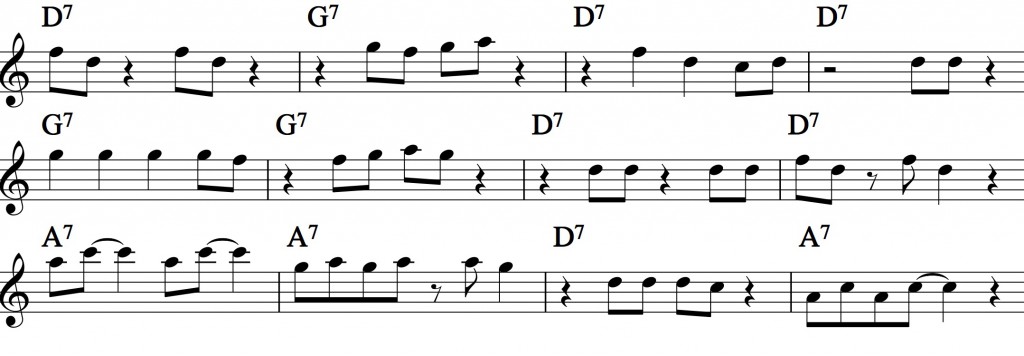
I begin with a rhytmical pattern on the one and three F D – F D on the second bar i start on the two of the bar playing all the notes of the G group, G F G A, the third bar play as quarter notes F D and end with eight notes C D. The fourth bar where i place two D´s as eight notes on the three sounds like an upbeat for the fifth bar where i continue with the quarternote pattern G G G – eightnotes G F – which i answer on the sixth bar on the second beat F G A G. In the seventh and eight bar i play a line in the group of D which definitely goes over the barline – On two and four i play D D which leads on to the second bar of D – F D and moved rhythmically F D. On the ninth bar i play a standard blues lick A C A C, kind of a shout which gets its answer on the tenth bar G A G A and ending with another answer A G, leading towards lower lines on the elleventh bar D D D C, going even lower ending on the twelvth bar with the shouth from bar ten A C A C as eight notes.
example three:
I now fully play eight note lines, in the bar but also extending the lines over the barlines, which is one of the goals with these exercises. Further i also change from only stating on the regular beats to also start a line on the off beats which gives the lines a more jazzy feeling.
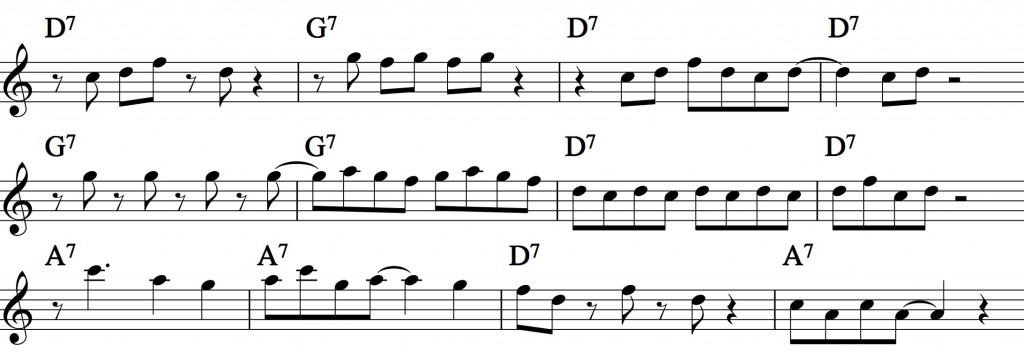
Bar one, i start on the lower note of the D group playing around the Root, C D F D leading towards bar two answering with the G group G F G F G, ending the sentence on bar three and four with a long eight note line over the barline playing around the D – C D F D C D—over the barline to bar four C D. Start a new sentence over the next four bars|G|G|D|D|in bar five, playing the G as off beats in bar five, continuing over the barline to bar six with playing around the G A G F G A G F leading down to the D and still continuing the line in eight notes D C D C D C D C ending in bar eight with an answer to it all leading toward the last D – D F C D. In bar nine i jump into a blues line in quarter notes, as an opposite of the eight notes just played before, A group – C A G continuing on bar ten A C G A ending bar ten leading towards bar 11 with a G going to the F D on bar eleven, Repeating the F D changing it rhythmically, ending on bar twelve with C A C A ready to start fresh on a next round 🙂
I really enjoy making these videos and it inspires me to practise my self, i hope it inspires you to do the same!
Enjoy and have fun playing 🙂
If you want to stay up-to-date with my videos:
subscribe to my newsletter (top left of my website)
and/or
subscribe to my youtube-channel.
You can also find me on twitter, instagram and facebook, google+ as sorenballegaard
Blues basics 2 – outlining the chords w/ pentatonic scale
This video is intended for the beginning improviser. I talk about the blues form and how you can easily apply a pentatonic scale and still outline the basic chord progression.
This is the second video in the series.

In the pentatonic scale of D minor, the notes D F G A C D, i find all the notes of the roots of the simple blues form.
on the first degree a D, on the fourth degree the G and on the fifth degree the A.

As you see the first bar is a D, second bar is G third and fourth bar is a D, in the fifth and sixth bar you have G, seventh and eights bar is D, ninth and tenth bad is A, the elleventh bar is D and the twelth bar is A.
I divided the pentatonic scale into three groups, one around each root of the basic blues scheme.

The groups consists of the root + one note from the pentatonic above the root and one note below the root.
The D group is root D + F above and C below, G group is root G + A above and F below, A group is root A + C above and G below.
These notes are all diatonic notes to the D pentatonic scale.
I will now slowly start improvising with these groups over the blues. This means that i actually outline the roots of the chords but still stay within very simpel and understandable material.
To learn the groups well you can play the following exercises.

You should try to learn these exercises by heart to be able to play it when you hear it and not when you see this on paper.
You can play these exercises using a metronome to also practise your timing while leaning these groups.
The is the group of G
set the metronome on fx. two and four. 
The group of A
metronome on 2+4 a bit faster.

Start slowly with the metronome in a slow tempo and get the notes into your ears and fingers.

The groups are defined by the roots of the blues.
The D group is root D + F above and C below, G group is root G + A above and F below, A group is root A + C above and G below.
Sourrounding the roots with the closest by diatonic notes of the D minor pentatonic scale.
Ill play a few more examples so you can see how to get on with this concept and use it yourself in youor solos.
The first example:

This example plays a steady rhythm on all bars and applys root of the group and the note below the root. fx. on D group the D and the C. Play through the form many times till you have this very firmly in your ears and fingers.
In the next exercise i change the rhythm and the note choice.
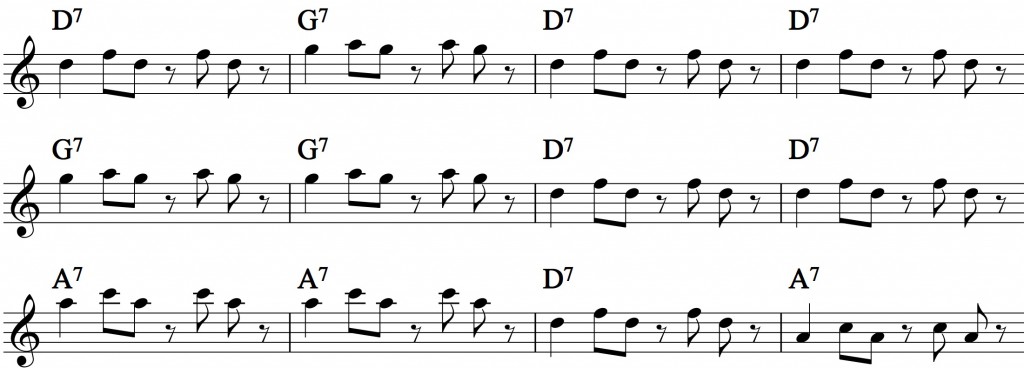
I now play the group root + the note above, fx in the G group i play the G and the Bb.
Try to lear the groups by heart and play as much as you can over the blues with the groups till its firmly planted in your ears and in your fingers.
I wish you very much good luck with this and hope to see you back soon.
Enjoy and have fun playing 🙂
If you want to stay up-to-date with my videos:
subscribe to my newsletter (top left of my website)
and/or
subscribe to my youtube-channel.
You can also find me on twitter, instagram and facebook as sorenballegaard
Blues basics 1 – outlining the chords w/ pentatonic scale
This video is intended for the beginning improviser. I talk about the blues form and how you can easily apply a pentatonic scale and still outline the basic chord progression.
Ill play the D blues and apply the Dminor pentatonic scale to the blues.

The notes are D F G A C D
To get the scale in your fingers and ears and down to the saxophone you should definitely play the scale over the whole range of the horn. 
From low D to the high F and back to the low D
Keep exercising the scale until you master it on the saxohone but als able to hear and recognize it.
The next exercise is playing the pentatonic scale from every step of the pentatonic scale from the D going 7 notes up and back to the D. Continuing from the F and 7 notes up and back. repeating this from every step of the scale.

If you can play it up you can also play it down:

These exercises trains your fingers but also your ears to hear the scale.
To play the blues you also need the form of the blues. I made a very simple blues scheme to practise on.

I use only the first, fourth and the fifht degree of the blues. First degree D7, fourth G7 and fifth degree A7.
The first chord is a D7 chord, then follows a G7, then two times D7.
In the 5th and 6th bar you find two times a G7 chord and there after in the 7th and 8th bar we have again two times D7.
The 9th and 10th bar we have the A7, in the 11th bar we have the D7 and ending in the 12th bar with a A7.
You can practise the form by only using the roots of the chords. Play the roots for four beats each follying the progression of the form

When you have gotten used to the roots of the chords playing them without music you should try applying music, pick a simple playalong track of the blues.

play this a couple of times so you get used to the sound of the music.
You can of course change the ocatve of the root. Try to improvise with what octave you play the root in.
I play the following round written down and there after I improvise two rounds woth playing the roots in different octaves.
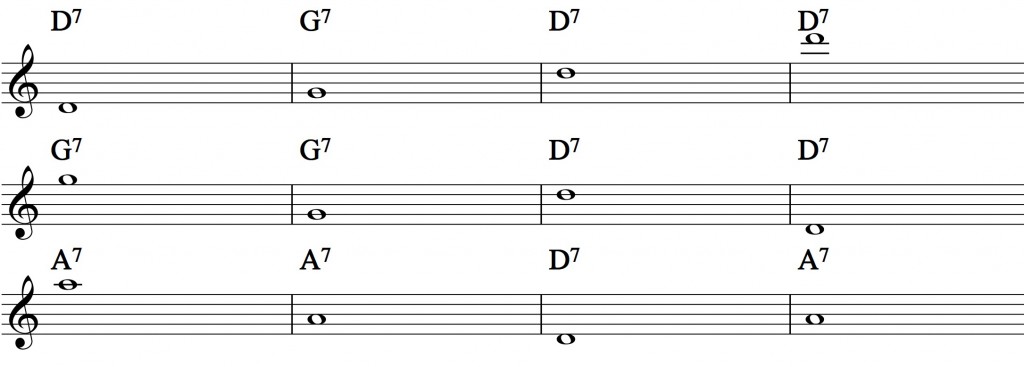
With this exercise i can explore the different sounds of the roots in different octaves and i can learn the how the chords of the blues move. Play these exercises intensly to learn this by heart, when you improvise you do not have time to check papers, the music has to come directly from your ear and be channeled directly to your saxophone.
When this is learned you can start applying different rhythms to the root notes of the blues.
Start change the rhythm and fool around with the different possiblities of rhythm in the bar, still playing only the root.
I made a little exercise of this. I have written out one chorus of blues and thereafter i will continue to improvise for two more choruses.

I continue for two more rounds:

i only use 8th notes in this exercise because i want to have that nice swing feel which is one of the most important factors in jazz. more advanced rhythmic patterns like triplets and 16th notes figures can be applied later. Now its time for the basics of the blues.
Listen to count basis, duke ellington, sammy nestico bigband music to get this feeling.
I hope you can use the notes,
Enjoy and have fun playing 🙂
If you want to stay up-to-date with my videos:
subscribe to my newsletter (top left of my website)
and/or
subscribe to my youtube-channel.
You can also find me on twitter, instagram and facebook as sorenballegaard
Diatonic approach 6 – minor II-V-I – 7th chords
In this video I give some exercises and examples in how to improvise over a minor II-V-I using the diatonic 7th chords.
I will focus on the minor II-V-I of Dm – Eø7-A7(b9)-Dm6(maj7).
In this progression ill talk about the 7th chords and how to use these in an improvisation.
The scales that i use are:

On Eø7 i play the F-major scale from the E on: E F G A Bb C D E F – E locrian scale
on the A7(b9) I play the Dm harmonisch toonladder from the A on: A Bb C# D E F G A Bb
i use the scale of Dminor melodic on the Dm6(maj7): D E F G A B C# D E

I play the Eø7 till the 11 – E G Bb D F A
The A7(b9) – A C# E G Bb
Dm6(maj7) D F A C# E
On each chord of the D minor II-V-I i have different 7th chords.
I can find these if i staple 7th chords up from the root/third and/or the fifth.
I start with the Eø7.

I play the Eø7 all the way to the 11 – Eø11 – E G Bb D F A
The following 7th chords can be extracted
Eø7 – E G Bb D
Gm7 – G Bb D F
Bbmaj7 – Bb D F A

On the A7(b9) we find:
on the root: A7 – A C# E G
on the third: C#o – C# E G Bb

The Dm6(maj7)
root Dm6 – D F A B
root Dm(maj7) – D F A C#
third Fmaj7(aug) F A C# E
I played the chords loosly, rubato like without time to be able to listen to the sound of the notes and get the finger combination into my fingers.
Ill get on with an exercise

This exercise is played over the chord progression Eø7 – A7(b9) – Dm6
Playing the 7th-chords going up from the root.
The second line of the exercise i play the 7th-chords from the 7th degree gooing back to the root.
These two ways of playing the chords are something you will often play in a solo and often hear in the solos played by other players.
The next exercise.

I now play the 7th-chords from the third going up and from the 9th, of the original chord, going down. The chords i play here you can see written out simply in the earlier examples here above.
The two last chords when im playing the progression down i play in a different inversion because I liked the sound better of these ones than the ones that matching the rest of the exercise. To work more with this try to play different inversions of the chords and see what you like the best.

This exercise takes you through some of the other chords i presented earlier. the exercise begins on the 5th degree of the Eø11 and then goes on with other possibilities as mentioned above.
In all the exercises above i begin the exercise on the second beat of the bar, just to get used to the sound of this. This will get into your ear and you will eventually also be able to start lines on the second beat the bar in your solo. The rhythm is the most essential of your solo so make sure when you practise that you always have a rhythmical aspect in your exercises. Most people use a lot of time exercising so why not exercise more things in one go!

This exercise works with a continous 8th note line so practising the timing of this and takes you through more arpeggios going up. Root till 7 and 7 till 9 – going up
What i repeat a couple of times in the video, which is also important in your soloing, what goes up can also come down.

Again a continous 8th note line but this one works with the chords decending.

I play the chords acsending from the 3rd to the 9 and from the 9th to the 11th with some minor changes in the chords. Look out!
![]()
The same exercise as above but this time playing the chords descending.
I have made some II-V-I examples by using the above mentioned material, the diatonic 7th chords.
Oc course i also use the scales and approach notes mentioned in earlier videos.
Here is the first example:

I begin by sourrounding the Bb, the 5th of the Eø7, with A and C then running up the Bbmaj7 chord up to the A running down the scale to the D on the A7(b9). The first two beats of the A7(b9) i keep playing the Eø7 resloving to the E of the A7(b9) on beat three, going down the C#o chord of the A7(b9). Resolving to the A of the Dm7 going up an inversion of the Dm6(add9) and on beat three running up the Dm6 ending on the last bar on the D going to the high E surrounding the B with the C# and the A.

I begin this example on the root of th Eø7 going up the scale, surrounding the F with the G and E running down the Gm7 chord, 3rd degree 7th chords of the Eø7. On the A7 i play a standard bebop line A G# G going down to the E, jumoing up to the root arpeggio A7 running up to the Bb in the Dm6 bar staying on the A7(b9) for two beats running down the augmented A triad A F C# to resolve to the 9th of the Dm(maj7) going down the arpeggio E C# A F ending on the second bar of Dm6 descending from the B of the Dm6 to the E.

The first arpeggio in this line is the Gminor triad, see my video on diatonic triads, ending in a standard jazz line playing the maj7 and the minor 7 of the Gminor chord. Jumping down to play the G running up the Gm7 chord over the barline to the A7 resolving to the A7(b9) on beat two ascending the scale of A7 to the C# playing down the C#o arpeggio. Resloving on the Dm to the F going up the Dm6(maj9) chord mixing the B (6), C#(maj7) and the E(9). Ending high on the A going down the chord again and on the last bar of Dm6 i go down the F9aug from the E, down to the F jumping to end on the 6th, B.
I really hope you enjoyed my exercises and examples.
If you want to be directly notified when a new jazz video is online then remember to sign up for my newsletter, just to the right of this text or subscribe to my youtube channel. You can also do both.
Have fun and enjoy the music!
Diatonic approach 5 – minor II-V-I – triads
In this video I get around the minor II-V-I in minor and explains how you can use the diatonic triads when you improvise. Eø7 – A7(b9) – Dm6.
I call the Dm6, by this name for this lesson but you can also call the tonic minor chord minor-major Dm(maj7), both are good but refers to the extensions of the chord.
The problem mostly found with the minor II-V-I is that you need three different scales to play diatonic over the progression.
The scale of the Eø7 is basically the Fmajor scale played from the E.
E F G A Bb C D E F
The A7(b9) scale is a D harmonic minor scale played from the A
A Bb C# D E F G A Bb
The scale I use over the Dm6 chord is D melodic minor
D E F G A B C#
I will now go on to the chord tones and focus on the diatonic triads in the chords.
The first exercise is the triads of the Eø7 – A7(b9) and the Dm6 in one exercise going through all the different diatonic triads found in the chords.
I put a little rest in there to also adress the rhythmical aspect of exercises. To make exercises not only finger technicalities.
The next exercise is an exercise without the breaks in it, this makes it more phisically demanding and also covers more material in shorter time, further it will adress the ability to think longer 8th note lines.

With these exercises I work with every chord for two bars. Two bars Eø7, two bars A7(b9) and four bars of Dm6. This is an outstretched II-V-I with double the amount of time on each chord. I have chosen to do this to extend the time on each chord.
I recommend that you of course use the above mentioned patterns but definitely also look for your own patterns to get really into the material. One of these methods are finding and developing own musical/technical patterns.
I will go on with som examples of the minor II-V-I which I made consisting of the scale material and the diatonic triads I have explained above.

I start this example going down the Bb major triad ending on a low E going up the Eø7 scale from the G to resolve to the C# on the A7(b9). Going up an inversion of the Bb diminished triad approaching the A with the notes Bb and G, going down the A augmented triad to the low A, resolving to the mid E on the Dm6 chord, which is an approach of the D through the E and the C#. From the D I go up the scale to the F jumping down to an A triad going up to the high A running down the scale and ending on the 9th an E.
Example 2.

I start the exercise with two combined triads, the one of Ediminished and the Dminor triad running up to the high G going donw the Ediminished triad in an inversion to the low G going on to the A of the A7(b9), jumipng up an octave to the high A approaching the F with the notes E-G. The F resloves to the E of an A triad going down ending on the low A jumping up to the high F of the Dm6 the third. Through the F, C#, E and the C# again im approaching the D minor triad played in a triplet figure up, continuing the rest of the example in triplets, approaching the A with the notes B and g, ending on C#,the maj7, high E, the 9th and finally ending on the B – the 6th.
Example 3.

I go down the Dminor triad, A F D, 11, 9, 7 of the Eø7, approaching with the D and the D the E, root of the Eø7, going down the Eo triad to the low E. Begin on an A of the A7(b9) jumping up to the Bb, flat9, approaching the G through the F and the A, picking up from under the Bb and the C#, b9+3 of the A7(b9), jumoing ip to the A, approaching on the Dm6 the F with the G as approach note. Using from the F, the third degree, the A augmented triad approaching the B, the 6th of the Dm6, with the C# + A, jumping up to the E going down the A triad. Approaching the F on the second bar Dm6 with the G+E, ending on some big jumps, A – E – B to C#.
I really hope you enjoyed the approach and the examples.
Diatonic approach 4 – Minor II-V-I
This video lesson explains the basic scales and chords used over a minor II-V-I – Am.
The minor II-V-I consists of three different scales, one on each chord of the II, the V and the I.
In this video i work on the Am6 II-V-I, Bø7, E7(b9) and Am6.

On the Bø7 chord the II of the II-V-I I play the Cmajor scale from the 7th degree, B C D E F G A B C,
on the E7(b9) i play A-harmonic minor from the Eof, E F G# A B C D E F,
and on the Dm6 i play D-melodic minor, D E F G A B C# D E.
These scales are maybe the most diatonic scales to the these functions.

I made a set of exercises which you can practise to get the scales well into your fingers but also into you ears.
the first exercise basically just plays the scale up from each chord over a four bar period.
I repeat the exercise, more times.
Second line of the exercise is playing the same material but descending.

The next exercise takes the scales from the third degree of each scale and again just plays the scale up.
Second line is playing the scale down.
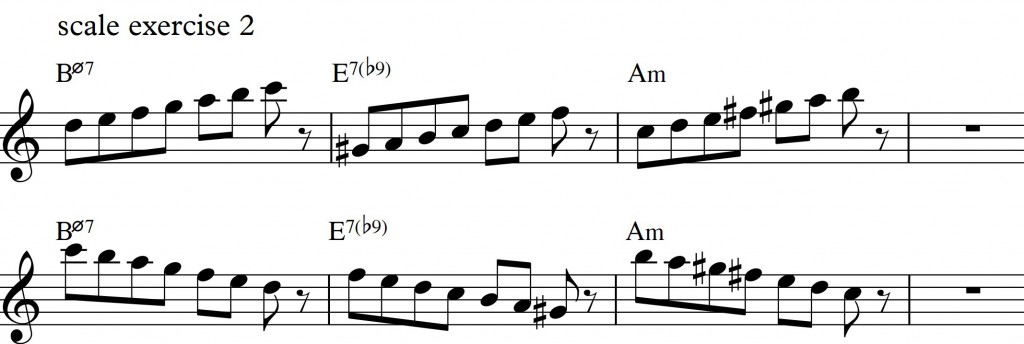
The arpeggios, the chord tones or the target notes which I sometimes calls the chord tones is the next matter.
on the Bø7(9) you have notes B D F A C, on the E7(b9) you have the E G# B D F and on the Am6 you have the A C E G# B.
I play the arpeggios till the 9th degree of the chord, because i like the sound of the 9th but also because its one of the most common extensions of the chords.

You can make up any exercise you want, i made the following exercise, playing the arpeggios up and down:


Try to find exercises that suits you.
I also like to play quarternote lines staying within the chordtones.
Here is an example of how this sounds:

I use only chordtones and the rhythm is quarter notes, so in this case, four notes in the bar.
the tones are: high A B D F on Bø7, E G# B D on the E7(b9), C A C E – G# A C E on the two Am chords,
next system is: B A B D, E B G# D, C A G# A, C G# A.
With this method you get the notes in your fingers and into your ear in a slow and controlled way.
The second quarter note, chord tone exercise:

The notes are: starting on high D B F D, B G# E D, C A G# E, C A G# B.
The lower system: A B D F, E D E B, C E G# E, C B A.
I will now play some examples of II-V-I lines. I only use the material I presented in this video in the examples.
I start on the 7th of the Bø7 going down making an approach through the E and G to the F going down the scale of Bø7. Hitting the B of the E7(b9) i continue down the scale to the G# running up the arpeggio of E7(b9) to the high F semi approaching the C of the Am6 with a E and D from above. On the C of the Am6 i jump down to play the E triad up one octave to the E, running down the scale to end on the B.
running up the complete arpeggio of Bø7 to the high C and from there going down the scale approaching the F of the E7(b9) through the g and E. From the F i go donw the scale to the G# going up the scale hitting a C on the Am major 9 chord going up the arpeggio to end on a high E making a glissando to the B.
i start with an approach to the F, via the E and G, going down the scale to the G# of the E7(b9) jumping up to the high F going down the scale to the C jumping again up to a high G# playing up to the high C to play th Caug triad down, followed by the E triad followed by a small tail E B C D.
Thank you for watching.
More videos, licks and tricks here
Diatonic approach 3 – diatonic 7th chords
In this video lesson I talk about the different 7th chords on a II-V-I in Dmajor.
I start with the scale of Dmajor, the scale has two sharps with the notes D-E-F#-G-A-B-C#.
I strongly recommend that you learn the scale, the notes and how it sounds on the saxophone.
Here is an exercise how to learn the scale even better.
The exercise start on the low D going to the high E, going back down to the low C# and ending on the low D.
This extends the exercise to almost the whole range of the saxophone and you develop your technique likewise. You can put any form to your exercises but make sure the meaning of the exercise stays intact, technique, speed, extremities of the horn etc.
This lesson will further discuss the diatonic 7th chords on a II-V-I in Dmajor. On each note of the Dmajor scale you have a chord that consist of 4 notes. I will play those chords.
Dmaj7 on the D – D-F#-A-C#, Em7 on the E – E-G-B-D, F#m7 on F# – F#-A-C-E, Gmaj7 on G – G-B-D-F#, A7 on A – A-C#-E-G, Bm7 on B – B-D-F#-A, C#ø7 on C# – C#-E-G-B.
All these 7th chords are very important tools to use in a solo, but also gives you an overview of the scale and the functions.
I will now play an exercise to get to learn the diatonic 7th chords better.
This exercise have a written out rhythm in it and is fitting in a 4-bar period.
You can make up any exercise in this matter pplaying the 7th chords going up or down, or both as long as the exercise fits whatever purpose you want to achieve.
The next exercise is the 7th chords going up but with no break in between, big breath!
This exercise you can easily play as 8th notes as here, but you can also play it as 16th notes with the metronome on the 1 of the bar, training the 7th chords and your timing.
You can also play the chords going down instead of up.
You can also try this exercise playing one chord up – one chord down. Looks like this.
Ill play this exercise faster to give an example of that you need to know this material very well.
The II-V-I in Dmajor have three different chords Em7 – A7 – Dmaj7.
Out of these chords you can find other diatonic 7th chords which also spells out the function of the II-V-I.
I extend the chords of the I-V-I to Em11 – A9 – Dmaj9
The first chords is Em11.
On the Em11 – E-G-B-D-F#-A, you find three different 7th chords.
On the first degree of the Em11 you will of course find the Em7 – E-G-B-D.
On the third degree of the Em11 you have a Gmaj7 chord – G-B-D-F# and on the 5th degree of the Em11 you have a Bm7 – B-D-F#-A.
On the dominant function of the II-V-I – the V, A9 – A-C#-E-G-B, we have two 7th chords, the A7 – A-C#-E-G and the C#ø7 – C#-E-G-B.
On the dominant function, A9, and on our tonic function, Dmaj9, we only have twho chords because if we get higher we get to the fourth degree of the chord which clashes very much with the third degree of the A9 – a D against the C# and the Dmaj9 – a G against a F#.
The root, our tonic function Dmaj9 – D-F#-A-C#-E we also have two chords, Dmaj7 – D-F#-A-C# and F#m7 – F#-A-C#-E.
Get to know these chords and functions well, they are very valuable in your soloing, transcribing solos of others and generally understanding music and what´s happening.
Fx. you dont always have to play up or down the Dmaj7 chord on Dmaj7 but you can easily use the F#m7 chord up or down. On the A7 you can use the A7 of course but also consider the C#ø7 chord which gives another sound. On the Em7 chord you even have three possibilities which are the Em7, the Gmaj7 and the Bm7 chord, check them all out.
Example 1 – II-V-I in Dmajor.
I start on the high D going down the Em7 chord, jumping up to the C#, going down the scale jumping down to the middle B playing up the Bm7 chord dragging over the Em7 (Bm7 chord) over the barline to A7 playing a small bebop lick going down the A7 scale to the C# of the Dmajor running up the C#ø7 chord of the A7 on the Dmaj7 approaching via the B+D, on top the C# going down the Dmaj7 7th chord ending on the C#.
Example 2 – II-V-I in Dmajor.
Starting on a Em11 chord in triplets going up to the A approaching the G through the A+F#, further approaching the F# on the A7 via G+E, jumping down to the low C# running up the C#ø7 chord ending high on a D+F# approaching the E, goiong down the scale to hit the C# on the Dmaj7 chord, jumping down to the D to play the Dmaj9 chord up approaching the D via E+C#, running from D up the Dmaj9 chord.
hint: check my video on diatonic approach notes here
Example 3 – II-V-I in Dmajor.
Going up the Gmaj7 chord of the Em9 approaching, through the F#+A, the G, going down the scale and via the D+B approaching the C# of the A9, playing the whole A9 chord in a triplet figure up to the high D of the Dmaj7, further up to the high F# going down the scale to the C#, jumping down playing the F#m7 up jumping to the A using a Coltrane line 5-3-2-1 on the Dmaj7 ending on the C#.
I hope you enjoyed the video and hope to see you back soon.
Diatonic Approach 2 – diatonic triads
In this video I talk about how to use diatonic triads in Gmajor.
Further i present the triads in the Gmajor scale and a II-V-I in G.
Diatonic triads is a strong tool which you can use in your soloing. Further by knowing the diatonic triads you get more overview of the theory of what you are playing. You get to know where all the chords are from and you attain flexibility in you improvisation.
The material we will work on is the G major scale:
![]()
Diatonic means that you are only using notes that are in the scale, so no notes outside the scale.
You would want to know your material by heart and also over the whole range of the saxophone.
The next exercise will help you with this.
![]()
The triads of the scale are each on one of the notes of the scale. This means you get 7 different triads in a major scale:
on the note G in the scale you have a Gmajor triad, on A you have a Aminor triad, on B you have a Bminor triad, on C you have a C major triad, on D you have a D major triad, on E you have a E major triad, on F# you have a F# diminished triad.
![]()
here is an exercise how to get this into your fingers:

This exercise is written to cover the whole range of the saxophone. Its important that you have flexibility with all material over the whole range of the saxophone because when you improvise you never know how you react to what is happening around you in a band. Maybe you need those high or low notes.
The exercise i just played was written with a little pause in between the triads, the next exercise is not,big breath!

This exercise without the pause in it will save you time when you practise, a very small amount but everytime you play the exercise you save this time, which you can use to practise more.
You can play the triads both up and down, like in the next exercise, first triad going up second triad going down:

The exercises mentioned here are free to use anyway you want, play the triads up, down, cluster them in groupings etc.
Its important that you know your material well to get more freedom in your soloing. Learn the names of the triads, make you own exercises, learn the triads over the whole range of the saxophone.
Ill now present the material of a II-V-I in G major – Am9 – D7(9) – Gmaj7(9).
There are different triads on each of these chords which i will explain in the following exercise:

The first chord, the Am9 with the notes A-C-E-G-B consists of three triads, the Aminor triad on the first degree of the Am9 chord A-C-E, the Cmajor triad on the third degree of the Am9 triad – C-E-G and the Eminor triad on the fifth degree of the Am9 chord – E-G-B.
The next chord in our II-V-I is the D7(9)

We begin with the complete D7(9) chord – D-F#-A-C-E. The triads of this chord is Dmajor triad on the first degree – D-F#-A. On the third degree of the D7(9) chord we have the F# diminished triad – F#-A-C and on the fifth degree we have the Aminor triad – A-C-E.
The last chord of our II-V-I is the Gmajor 9 chord – G-B-D-F#-A.
![]()
The three triads on the Gmaj9 chord are: on the first degree, Gmajor triad – G-B-D, on the third degree, the Bminor triad – B-D-F# and on the fifth degree there is the Dmajor triad – D-F#-A.
One of the best ways to get this material into your fingers is naturally to play the above mentioned exercises but as soon as you know the material just a bit start to get it into live material like lines you make and play, licks etc.
I have made some examples of lines that uses the diatonis triads, the first line:
![]()
I start playing a Eminor triad down ending on a B going up the Cmajor triad. Using diatonic approach notes G and E to hit the F# on the D7 chord. Playing down the scale from F# to D jumping down to a F# playing up the F# diminished triad running down the scale from C to A. Jumping up to a D on the Gmajor9 shord playing down the Bminor chord ending on a E on Gmajor9.
The next example:
![]()
I start with a Eminor triad on the B jumping down to play the triad up, playing the scale down from a till E. Jumping on to the D7(9) dragging the Aminor triad to the D7(9) in a triplet playing it down. I use the diatonic approach notes G and E to get to the F# playing down the scale. eight note rest on Gmajor9 playing the Bminor triad down ending on an A repeating the Bminor triad ending on the low D approaching the end F# with a E – A to F#.
The third example:
![]()
I play up the Aminor triad with a triplet figure, ending on the high G going down the Cmajor triad using a diatonic approach over the barline G – E to F# of the D9 playing down the Dmajor triad, jumping to the high B playing down the scale extending the F# over the barline playing down the Bm triad jumping up to the F# going down the scale to pull over a D across the barline to end on a Bm triad going down ending on an E.
To see more of my lesson videos, click.
and click to subscribe to my youtube channel












